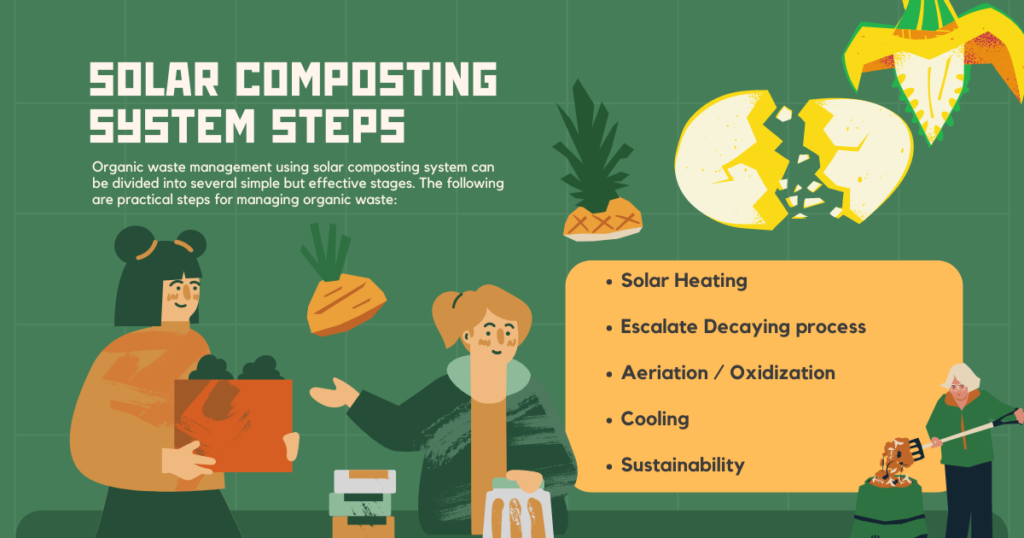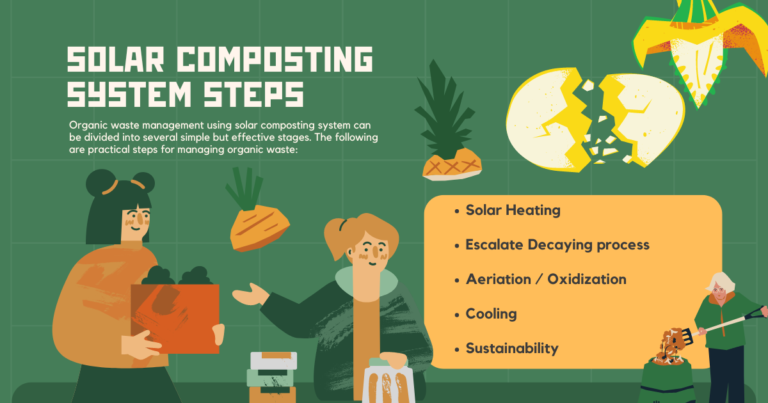Future of Composting: Solar Innovations for Sustainable & Organic Waste Management System
Did you know, creating organic compost by using solar energy is an ecofriendly innovations that could help us produce an optimal level waste management system which also benefits us by optimizing a sustainable means to manage organic waste.
What is Solar Composting?
Solar composting is an Creative and Environment-friendly technique of composting that utilizes solar Power to speed up the decomposition of organic matter. This process incorporates the basics of traditional composting with the sustainable use of solar energy, making it well organized and a highly cost effective approach to waste management.
How the Solar Composting Works?
-
Solar Heating:
Solar composting systems are manufactured to trap and harness solar energy. Solar panels are designed as transparent cover sheets that absorb heat from the sun, raising the internal temperature of the composting container.
-
Escalate Decaying process:
The raised temperature within the composting system accelerates the decaying activity, which is crucial for breaking down organic matter. Higher temperatures speed up the decaying process and help in killing pathogens and weed seeds.
-
Aeration / Oxidations:
Solar composting also requires a sufficient amount of aeration and moisture control. Some solar composting systems include ventilation set-up or manual turn-off device to ensure appropriate oxygen flow to preserve optimal moisture levels.
-
Cooling:
Many solar composters are wrapped to retain the heat produced during the day, allowing the composting process to continue successfully even during cooler nights or cloudy weather.
-
Sustainability:
Solar powered composting systems reduce the dependency on electrical power, which makes them imperishable and productive. They also produce nutrient-rich compost at an expeditious rate, which can be used to enhance the soil’s fertility and help in plant growth.

What are the Benefits of Solar Composting?
-
Save Energy
Solar composting harnesses renewable energy, minimizing the use of fossil fuels and reducing greenhouse gas emissions.
-
Quick Results
The raised temperature accelerates the decaying process and results in producing compost 3 times faster than traditional methods, that is, in 10 days.
-
Kills Pathogen
High temperature helps in killing harmful pathogens, which results in compost that is safe to use.
-
Eco-Friendly
Solar composting is a sustainable waste management solution that minimizes environmental impact.
-
Highly Cost-effective
Reduced energy consumption and faster compost production can lead to cost savings over time.
Solar composting is an optimal solution for individuals, communities, and businesses looking to adopt environment-friendly waste management methods. It combines the benefits of composting with the advantages of solar energy, promoting a more sustainable and eco-friendly approach to handling organic waste.
What are the components of a Solar Composting Machine?
-
Solar Panels
The panels trap the sunlight and convert it into electricity through photovoltaic cells. The amount of electricity produced completely depends on the size and potential of the solar panels.
-
Electric unit
It includes components like a motor, fans, and sensors that regulate the composting process. These components are runned by the electricity produced from the solar panels.
-
Composting Containers
These containers are where the organic waste matters are unloaded for composting. The container is created to enhance the conditions such as temperature, moisture, and aeration to accelerate the decaying process.
-
Aeration/Oxidation
Composting requires oxygen for aerobic decomposition. Solar-powered composting systems may use fans or blowers to provide necessary airflow within the composting containers
How the solar composting machine works?
Solar composting machine are used for composting which save the electrical cost. It is easy to use as compare to Electrical composting machine. Its functioning is different than the electrici powered machines.
Solar composting machine uses the principles of segregation, heating, mixing, ventilation technology. To increase the number of microbial in the decaying matter a carbon source is used. (Sawduct or cocopeat)
Below are given the step of how the solar composting machine works:

-
Segregation
In this step, the segregation of wet waste is done on the basis of what is considered as organic and inorganic. This process is preformed manually and is very important.
-
Shredding
In this step, a shredder is used to break-down the wet waste into small particles. When crushed into a smaller size the process of decomposition takes less time compare to the traditional decompostion process. Depending on the capacity there are different type of shredders, which are give below:
| Sr. No. | Shredder Capacity | Single Shaft Chopper Type | Double Shaft Shredder |
| 1 | 1HP | 70Kg/hr | 50Kg/hr |
| 2 | 2HP | 140Kg/hr | 100Kg/hr |
| 3 | 3HP | 250Kg/hr | 200Kg/hr |
Also read:- What is Shredder and how many types of Shredders
-
Mixing
In this step, the crushed/shredded mixture is transferred to the compost machine, where you add 10% of sawdust/ cocopeat to absorb the moisture. A pillow-block technology is used to rotate the drums or tanks and a crank handle machanisim to rotate the blade inside the tank.
-
Heating
The process of heating takes place in 2 ways, first the heat generated with the black coloured containers by absorbing the heat from the sun and second the use of carbon source leads to increase the temperature which generates heat internally.
-
Cooling
This is the last step, in which the product is kept for cooling since its temperature rises up to 60-70 degrees in the mixing process. It takes 1-2 days to degrade the temperature to get the final compost.
Conclusion
Solar Composting system not only provide an effective steps for managing organic waste but also contributes positively to the eco-system by reducing carbon gas emissions, preserving natural resources, promoting sustainable methods, and enhancing soil health and biodiversity. It supports broader sustainability goals and highly contributes towards building resilient and eco-friendly communities.
The future of solar composting technology is distinguised by advancements in effective production, unification of latest technologies, managability, dependability, reliability and increased sustainability. As the world keeps on prioritizing environmental stewardship and sustainable development, solar-powered composting systems are poised to play a vital role in reduce the waste, maintaining resources, and promotion of renewable energy resources. Proceeding with the research, innovation, and co-operation across different provisions will be key to realizing the full potential of this technology in conveying global environmental challenges. And for more details you can visit our website klimrus.

